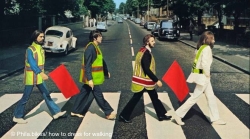
You may relate to this. In a Delta neighbourhood there is a residential street that is the shortest distance between two arterial roads, favoured by GPS apps, tradesmen and taxis and is a block shorter for arterial short-cutting cars.There are no sidewalks, no indication that pedestrians are walking on the street which includes a blind corner on a hill with no pedestrian clearance. At 50 kilometers per hour the inevitable has happened, with high traffic volumes and speeds resulting in the killing of a neighbour’s dog, one transmission gutted on a front lawn and cars ending up in neighbours’ yards and through their hedges. Add in a few nearby “golf” communities where older seniors drive to services in their garaged polished cars at speed through this residential street to get to an arterial. The fact it is a residential local street and that short cutting should not be happening is not of interest to the GPS apps or drivers, and puts local walkers and cyclists at risk.
Kudos to Leonia New Jersey (across the Hudson River from New York City) which realized that these “alternative routes” don’t just manifest themselves in driver behaviour, but are also suggested by services like Google Maps, Waze and Apple Maps. As the New York Times notes these apps have resulted in traffic-choked towns where people have been circumventing traffic and choosing shorter routes due to GPS services. And Leonia has had enough: “In mid-January, the borough’s police force will close 60 streets to all drivers aside from residents and people employed in the borough during the morning and afternoon rush periods, effectively taking most of the town out of circulation for the popular traffic apps — and for everyone else, for that matter.”
“Without question, the game changer has been the navigation apps,” said Tom Rowe, Leonia’s police chief. “In the morning, if I sign onto my Waze account, I find there are 250,000 ‘Wazers’ in the area. When the primary roads become congested, it directs vehicles into Leonia and pushes them onto secondary and tertiary roads. We have had days when people can’t get out of their driveways.”
The Waze app uses crowd sourcing to update its information which has resulted in some neighbourhoods “fabricating accidents” to stop the flow of motorists using the app. While defending the app’s right to reroute vehicles from congested roads to residential streets, Waze also says it “shares free traffic data with municipal planners nationwide”, as if the good of more vehicle planning outweighs the rights of residents to the safe and comfortable use of their street. Indeed Waze says that if a road is “private” it will not be used by the app. How many “private streets” in your community?
Unlike other communities that have installed turn restrictions and speed humps, Leonia’s approach has been proactive against congestion and short cutting caused by apps. Residents will be issued special tags for their cars, and other users of the street will be fined $200 in the rush hours. The police department has notified the major traffic and navigation apps of the changes and fully intends to enforce local use of their streets. While other elements like traffic barriers or street closures are the more preferential way to keep traffic out, the approach taken is a policing one. As the Chief of Police of Leonia says “It’s basically all or nothing . It’s a very extreme measure for very extreme traffic. Would I prefer not to do this? Of course. But I would rather try something and fail than not try anything.”


